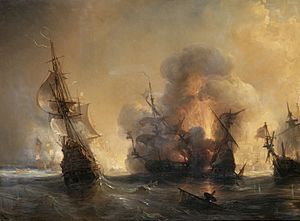Battle of Lagos (1693) facts for kids
Quick facts for kids Battle of Lagos |
|||||||
|---|---|---|---|---|---|---|---|
| Part of the Nine Years' War | |||||||
 Battle of Lagos by Théodore Gudin |
|||||||
|
|||||||
| Belligerents | |||||||
| Commanders and leaders | |||||||
| Strength | |||||||
| approx. 100 sail, of which 70 ships of the line 30,000 crewmen |
21 ships of the line |
||||||
| Casualties and losses | |||||||
| 500 killed or wounded no ships lost |
2,500 killed or wounded 2,000 captured 90 merchantmen, of which 40 captured 1 English ship of the line destroyed 2 Dutch 64-gun warships captured |
||||||
The Battle of Lagos was an important sea battle. It happened on June 27, 1693. This battle was part of a bigger conflict called the Nine Years' War. A French fleet, led by Admiral Anne Hilarion de Tourville, fought against an English and Dutch fleet. The English and Dutch ships were commanded by Admiral George Rooke. The battle took place near Lagos Bay in Portugal. Admiral Rooke's ships were protecting a group of merchant ships. This group was known as the Smyrna convoy. Sometimes, people call this battle the "Smyrna convoy action." The French won this battle.
Contents
What Led to the Battle?
In the spring of 1693, a large group of ships was put together. This group, called a convoy, would carry English and Dutch merchant ships. These ships were going to Spain and the Mediterranean Sea. They had been waiting because of the danger of attacks. French warships or privateers (ships that attacked trade) were a big threat.
The Convoy's Journey
The convoy had over 200 merchant ships. It was protected by a strong group of warships. This group included eight English and five Dutch warships. There were also smaller ships like fireships and scouts. Vice-Admiral George Rooke and Rear Admiral Philips van der Goes led this protecting group. Their job was to go to the Mediterranean and stay there.
At first, a larger group of allied warships helped the convoy. This bigger fleet made sure the convoy passed the French port of Brest safely. After that, the main allied fleet turned back. They needed to protect England from invasion.
France's Plan
The French had rebuilt their navy after losing ships the year before. But they decided not to invade England. Instead, they chose to attack the allies' trade. This was called a guerre de course, or "war on trade."
King Louis XIV of France sent his fleet to set a trap. Admiral Tourville, France's best commander, led this fleet. By the end of May, Tourville had gathered 70 warships. With other support ships, he had about 100 ships in total. He waited near Lagos Bay in Portugal.
The convoy sailed at the end of May. The main allied fleet had 24 Dutch warships and 45 English warships. They sailed with the convoy for a while. By June 7, the convoy was about 150 miles southwest of Ushant. The main allied fleet then turned back. They left Rooke and the convoy to continue south.
The allies did not know where the French fleet was. They only found out on June 17. By then, Rooke and the convoy were already fighting near Lagos. The French had spotted them that morning.
The Battle Begins
Admiral Rooke could not avoid the fight. But his ships were in a good position because of the wind. He ordered the merchant ships to scatter and sail away. His warships then got ready for battle.
Heroic Sacrifice
The battle started around 8 PM. The French ships quickly caught up to the back of Rooke's group. Two Dutch ships, the Zeeland (64 guns) and the Wapen van Medemblik (64 guns), bravely fought the French. They sacrificed themselves to give the other allied ships time to escape. They fought very well.
When the two Dutch ships finally surrendered, Admiral Tourville was very impressed. He asked their captains if they "were men or devils." Rooke later said it was "one of the best judged things I ever saw in action."
Rooke's Escape
The next day, Rooke was sailing west with 54 merchant ships. Only four French warships were chasing them. As the French ships got closer, Rooke's main ship, the Royal Oak (100 guns), turned to face them. After a short fight, the French ships gave up the chase.
Rooke and his group reached Madeira safely. There, he found another English warship, the Monck (60 guns), and one Dutch warship. He also found 40 or 50 more merchant ships. With these ships and others he picked up, Rooke reached Ireland by July 30.
What Happened After?
More than half of the convoy was saved. However, about 90 ships were lost. Most of these were Dutch. The French captured 40 ships as prizes. The rest were destroyed.
The convoy had two main goals. First, to get the merchant ships to their destinations in the Mediterranean. Second, to set up a naval base there. Both goals failed.
For the French, this was a huge win. They captured goods worth a lot of money. In London, people said it was the worst financial disaster since the Great Fire, which happened 27 years before. For Admiral Tourville, this victory was a great revenge. He had been defeated in the Battles of Barfleur and La Hogue just one year earlier.

